Using thorny bushes and shrubs is a great way to enhance the security of your property while still maintaining the beauty of your garden. These prickly plants create a natural defense barrier that can deter unwanted visitors. Additionally, evergreen shrubs with thorns offer year-round privacy due to their dense foliage, spines, prickles, and thorns.
It is important to choose prickly bushes with strong or stiff spines or spikes. These can include plants with jagged foliage, thorny stems, or spicy berries. When used correctly, spiky plants can add an attractive balance to your garden landscape without making it look like a fortress.
This guide offers tips and advice for incorporating thorny plants into your garden for both their ornamental beauty and their protective qualities.
What Are Thorny Bushes
Thorny bushes, also known as spiky plants, can be utilized as privacy hedges and natural barriers to protect your property from intruders. These plants not only provide security, but also add aesthetic appeal to your landscape, with many of them producing beautiful blooms. Additionally, evergreen shrubs with thorns serve as a year-round noise and visual barrier.
Thorny plants come in various forms and sizes, such as those with pointed spines, serrated foliage, or thorny stems. They can be used as an alternative to traditional security measures, such as razor wire or fences, while still offering the same level of protection. With their dual function as both an ornamental and defensive addition to your garden, thorny bushes are a great choice for any homeowner looking to enhance their property’s security and appearance.
Why Plant Thorny Bushes as Defensive Plants
Using tall spiky plants as a perimeter barrier is an excellent way to deter unwanted visitors from entering your property. Security plants not only serve as a deterrent, but they also keep out unwanted wildlife. When it comes to deer-proofing your garden, constructing tall barriers may not be feasible. Smaller animals, such as rabbits, may also slip through small openings in walls or fences. However, they will have a difficult time navigating through a defensive hedge without getting hurt. Living fences covered in prickly plants make it difficult for unwelcome animals to climb or cross over, providing an effective barrier against intruders.
Where to Grow Prickly Plants and Thorny Shrubs
If you plan on planting thorny plants or prickly shrubs, it’s important to be strategic about their placement. Keep in mind the potential danger of the sharp spines and thorns and avoid planting them near areas where children and pets play or walk. Here are some recommended locations to plant thorny plants for their defensive properties:
- To prevent burglars from gaining access to your home, plant thorny shrubs below windows and along the foundation of your house.
- A row of tall spiky plants or blooming shrubs with thorns can serve as a deterrent to unwanted visitors along walls or fences.
- Rather than installing a fence, strategically plant thorn bushes in areas where deer, cats, stray dogs, rabbits, and other pests may enter your property.
Other Benefits of Thorny Bushes in Your Garden
Planting a prickly hedge along your property’s borders can provide numerous benefits beyond defense. These living fences are often easier to maintain than traditional fences, making them a low-maintenance option.
Thorny bushes also add an element of seasonal interest and beauty to your landscape, with options available in a variety of colors including red, purple, white, orange, pink, and yellow. Additionally, they can serve as natural windbreaks, noise barriers, and habitats for beneficial creatures and insects.
How to Handle Thorny Shrubs and Spiky Plants
In order to grow spiky shrubs and prickly plants in your garden, you’ll need to be extra careful. Long, stiff, sharp, and vicious-looking spines on prickly bushes may penetrate the skin. Moreover, irritants may be found in the thorns of certain defensive plants.
As a result, it’s always a good idea to handle thorn bushes using protective gear. Use puncture-resistant gloves before pruning, replanting, or working with a thorny plant to protect your hands from injury. When pruning branches with thorns, wearing goggles is also a good idea. Boots with large soles may also help protect you from stumbling across jagged spurs.
How to Identify Bushes with Thorns
The presence of thorns or spines on a shrub’s stem can help identify the species of ornamental plants. However, it is important to also consider other identifying characteristics such as the appearance of the leaves, growth patterns, size, blossoms, and fruit in order to accurately classify the shrub. Examining all these characteristics will help in correctly identifying the species of the shrub.
Types of Thorny Bushes (With Pictures)
Let’s take a closer look at the different types of thorn bushes that may be used as security bushes or defensive plants.
Thorny Bougainvillea Bushes and Vines

Bougainvillea is a striking evergreen flowering vine that features long arching thorny branches available in a range of colors such as blue and purple. This plant is an excellent option for discouraging people from climbing over walls or fences due to its thorny stem.
The spreading vine can attach to buildings or other plants and grow up to 24 feet (12 meters) tall. Bougainvillea is a popular vine in warm regions such as Florida, South Carolina, and Mediterranean countries. It can thrive in fences, hanging baskets, and pots, and is drought-tolerant. Heart-shaped leaves, showy papery flowers, and sharp spikes on branches are all hallmarks of bougainvillea. It is best to grow bougainvillea in warm climates with full sun exposure, particularly in USDA zones 9-11.
Crown of Thorn Plants (Euphorbia milii)
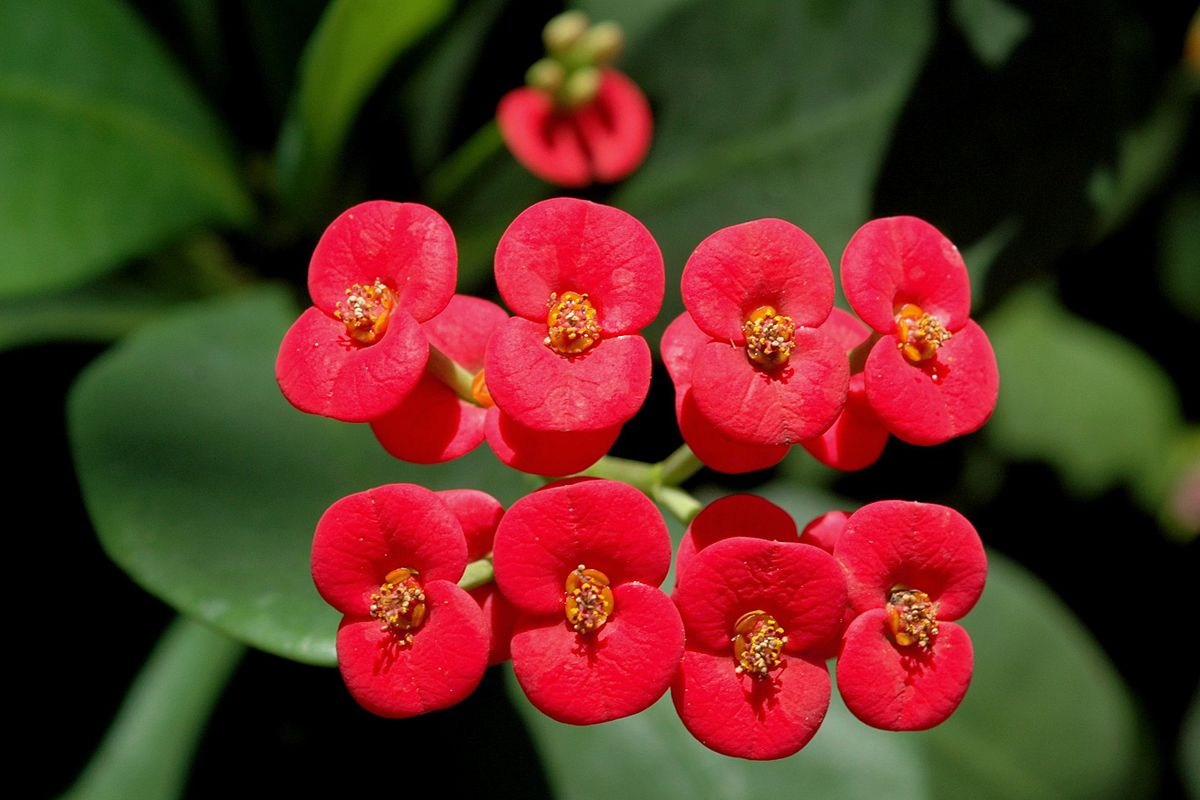
Euphorbia milii, also known as the Crown of Thorns, is a medium-sized thorny shrub that produces round red or pink bract blooms and has bright green leaves. The woody shrub is identified by its long spines that grow up to 1 inch (2.5 cm) long, making it a great security bush.
The plant produces a mildly toxic white sap and is also known as the Christ Plant or Christ Thorn. The Crown of Thorns can grow up to 5 to 6 feet (1.5 to 1.8 meters) and thrives in full sun. It is suitable for use as a defensive garden plant in areas 9 through 11 and is recognized by its zig-zag pattern of thick spiny stems, bright green leaves, and colorful bracts.
Thorny Firethorn Shrub (Pyracantha)
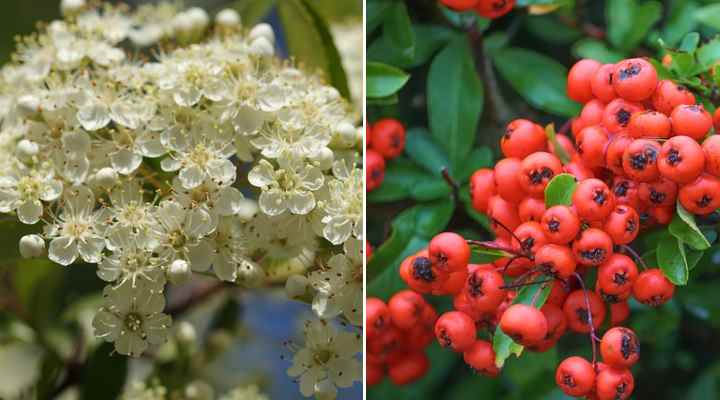
Firethorn is a thorny shrub that bears berry-like fruit in late fall and has small oval-shaped green leaves with clusters of white blooms. Its dense, prickly structure makes it ideal for use as a protective hedge, a border defense, or as a specimen plant. The height of firethorn bushes can range from 6 to 16 feet (1.8 to 5 meters).
Firethorn bears a resemblance to the cotoneaster plant because of its clusters of crimson berries. However, unlike the ground cover cotoneaster shrub, firethorn has numerous thorns along its stems. It grows best in full sun to partial shade and is suitable for USDA zones 6 through 9. Firethorn shrubs are distinguished by their white flowers, slender green leaves, bright crimson berries, and formidable thorns.
Thorny Rose Shrub (Rosa rugosa)

Thorny rose shrubs come in different cultivars, each having woody canes with sharp thorns. These spreading bushes thrive in various soils and produce beautiful pink flowers followed by large orange rose-hip berries. Thorny rose bushes can grow between 4 to 6 feet (1.2 to 1.8 meters) tall and wide.
These rose bushes are known for their stunning pink flowers, lush green leaves, and abundant small thorns on the branches. Thorny rose bushes are ideal for USDA zones 3 to 8 and prefer full sun to partial shade.
Agarita (Mahonia trifoliolata)

Agarita is a spiny shrub that has holly-like leaves and yellow flowers. It is highly ornamental due to its gray-green foliage, yellow cup-shaped flowers, and red berries. The plant can grow up to 6 feet tall and 6 feet wide, and has thorny leaves. Agarita bushes grow best in full sun to partial shade in USDA zones 7 to 9.
They are useful as border plants, foundation plantings, or for erosion control on banks and slopes. However, in some states, agarita is considered invasive. The plant is characterized by its three-leaf leaflets, yellow blooms, and edible red berries.
Japanese Barberry (Berberis thunbergii)

A highly effective security hedge, the Japanese barberry is a thorny shrub with crimson berries. Also referred to as Thunberg’s barberry or red barberry, this plant has sharp spines that grow at the nodes of its leaves. It can grow up to 3-6 feet tall and has a spread of 7 feet. The Berberis thunbergii f.purpurea is a cultivar of Japanese barberry that has purple leaves, making it a popular ornamental plant as well.

Berberis thunbergii, also known as Japanese barberry, is a variety of Berberis. It is an excellent defensive plant that can be used as a foundation planting, protective hedge or screen, or grown along a fence. The bright foliage, clusters of crimson fruits, and bushy nature of atropurpurea (Japanese barberry) give this decorative shrub year-round appeal. It grows best in sunny or partially-shaded areas in USDA zones 4 to 8.
Japanese barberry can be identified by its densely growing spiny branches, clusters of drooping yellow flowers, and bright shiny red berries. It is a great choice for those looking for a low-maintenance and decorative security plant.
Chinese Quince (Chaenomeles speciosa)

The Chinese quince bush is a beautiful multi-branched shrub that bears pinkish-white or crimson flowers and apple-like fruits that are edible. It is a spiky and ornamental plant with beautiful blooms that appear on bare, thorny stems in early spring. The deciduous leaves of the Chinese quince turn scarlet in autumn and have prominent thorns on the branches.
Chinese quince thrives in full sun and well-drained soil in USDA zones 4 to 8. Due to its dense and spiky branches, it makes an excellent security hedge, privacy screen, or property barrier. The Chinese quince can be identified by its masses of pink or crimson 5-petaled flowers, thick growth, spiky branches, and tart edible fruit.
Sea Buckthorn (Hippophae rhamnoides)

The sea buckthorn is a spiky shrub with thin, silver-green leaves and bright yellow or orange fruits that grow well in sunny or partially shaded areas with minimal upkeep. These multi-stemmed shrubs can reach heights of up to 8-12 feet (2.4-3.6 meters) and widths of 2-3 feet (0.9-1.1 meters). The shrub’s yellow-orange berries last through the winter, adding to its decorative value.
Due to its height and rounded, dense growth, the sea buckthorn is ideal for use as a windbreak, security screen, or mass planting along the edges. It has long, slender, lance-shaped leaves with sharp, stiff spines and orange clusters of healthy berries.
Common Hawthorn Spiky Shrub (Crataegus monogyna)

Common hawthorn is a thorny shrub or tree with white flowers and bright red fruits. It is a great defensive hedge due to its deeply rooting branches, sharp 1″ (2.5 cm) thorns, and low maintenance requirements. The spiky hawthorn bushes can grow up to 15 to 45 feet (5 to 14 meters) tall.
The thorny shrub is best grown in USDA zones 5 to 7 and is also known as oneseed hawthorn, maythorn, or quickthorn. Hawthorn produces creamy-white flowers and red fruits in full to partial sunlight. The common hawthorn shrub can be identified by its little lobed leaves, fragrant clusters of white flowers, and crimson autumn fruits.
Spiky Blackberry Shrub (Rubus fruticosus)

Blackberry shrubs are robust and defensive plants that have long, curving, and thorny stems. They are deciduous flowering plants and can be seen with either evergreen or deciduous leaves based on the climate. Blackberry shrubs produce a large number of edible berries in the spring.
They can be grown as a defensive ground cover or hedgerow, thriving best in full sun. These plants can reach up to 6.5 feet (2 meters) in height and grow in USDA zones 3 through 8. The serrated edges, clusters of pinkish-white blooms, and prickly branches distinguish blackberry shrubs from other shrubs.
Common Holly (Ilex aquifolium)

Common holly is a popular hedge shrub known for its sharp, prickly leaves and bright red berries, which make it a common sight in gardens throughout the year. The spiky leaves of holly bushes are a great defense against animals trying to cross the barrier. Typically growing up to 7 to 10 feet (2.1 to 3 meters) tall and wide, holly plants thrive in full or partial sunlight in USDA zones 6 through 10.
They are ideal for use as a tall perimeter security hedge when pruned as a foundation planting or along a fence. With deer and rabbit-resistant thick foliage, common holly is characterized by its thorny leaves with wavy edges, abundant clusters of tiny white blooms, and glossy red berries that last well into the winter season.
Spiked Blackthorn (Prunus spinosa)
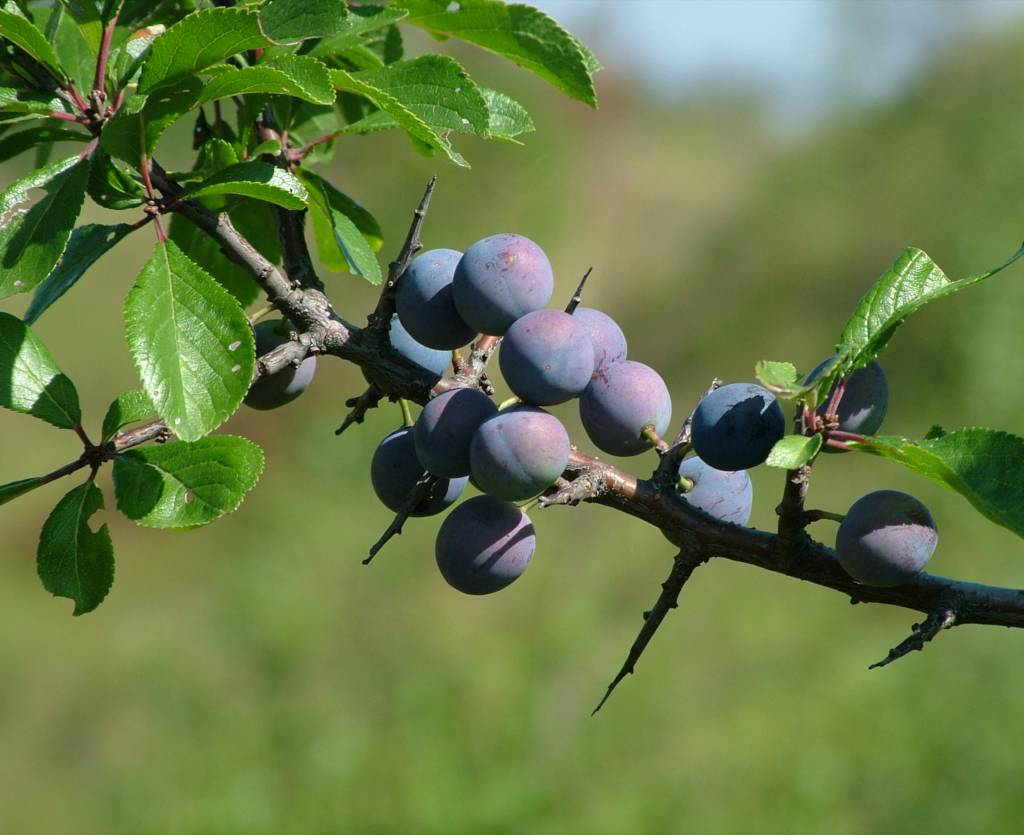
Blackthorn is a deciduous shrub that has spiky branches and can be grown for its defensive features. Its elongated oval leaves are adorned with blue drupes known as sloes. As a low-maintenance, spiky landscaping shrub, the prickly branches of blackthorn are ideal for garden security. The shrub can grow up to 16 feet (5 meters) tall and wide, making it perfect for creating a large defensive barrier.
Blackthorn produces creamy-white blooms with five petals and blueberry-like purple-blue drupes. It has small oval leaves that measure 0.8″ to 1.7″ (2 to 4.5 cm) long. Blackthorn can grow well in full sun to partial shade, and it is hardy in USDA zones 6 through 9.
Porcupine Tomato or Devil’s Thorn (Solanum pyracanthos)

The porcupine tomato is a small evergreen shrub with fuzzy gray leaves and straight orange spines that grow on leaf edges and stems. This prickly plant also produces lovely lavender-colored flowers that bloom all year long. Porcupine tomato is known for its ornamental value and its spiny defensive structure.
The spiky leaves of porcupine tomato grow between 2.3 and 8 inches (6 to 21 cm) long, and the plant itself can grow up to 5 feet (1.5 meters) tall. It thrives in USDA zones 9 to 11 and can tolerate both full sun and light shade. The deeply lobed gray-green leaves with orange spines growing from them are the primary identifying characteristics of the porcupine tomato.
Oregon Grape (Mahonia aquifolium)
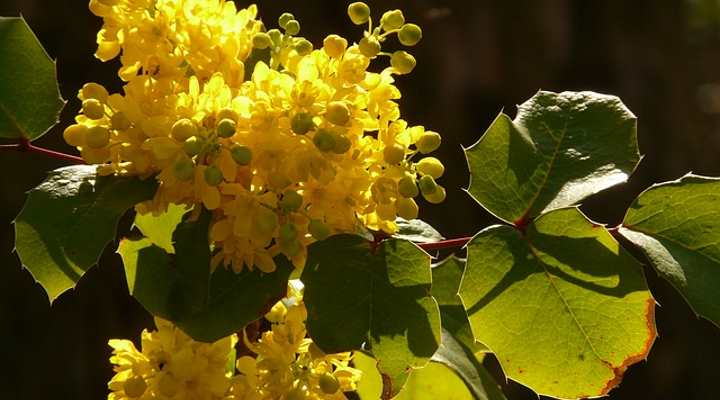
Oregon grape is a versatile evergreen shrub that can thrive in both sunny and shady locations. It produces clusters of bright yellow blooms and dark purple berries. Also known as holly-leaved barberry or Oregon grape-holly, this medium-sized shrub can grow up to 3-6 feet (1.8-1.8 meters) tall.
Oregon grape-holly is an excellent choice for decorative security hedges in shade gardens, as well as for foundation plantings and border shrubs to protect your property. Its glossy green leaves with spiny margins, golden yellow flowers, and clusters of edible blue berries are all distinguishing features of the Oregon grape shrub. It grows best in USDA zones 5-8, in both sunny and shady areas.
Fuchsia-Flowered Gooseberry (Ribes speciosum)
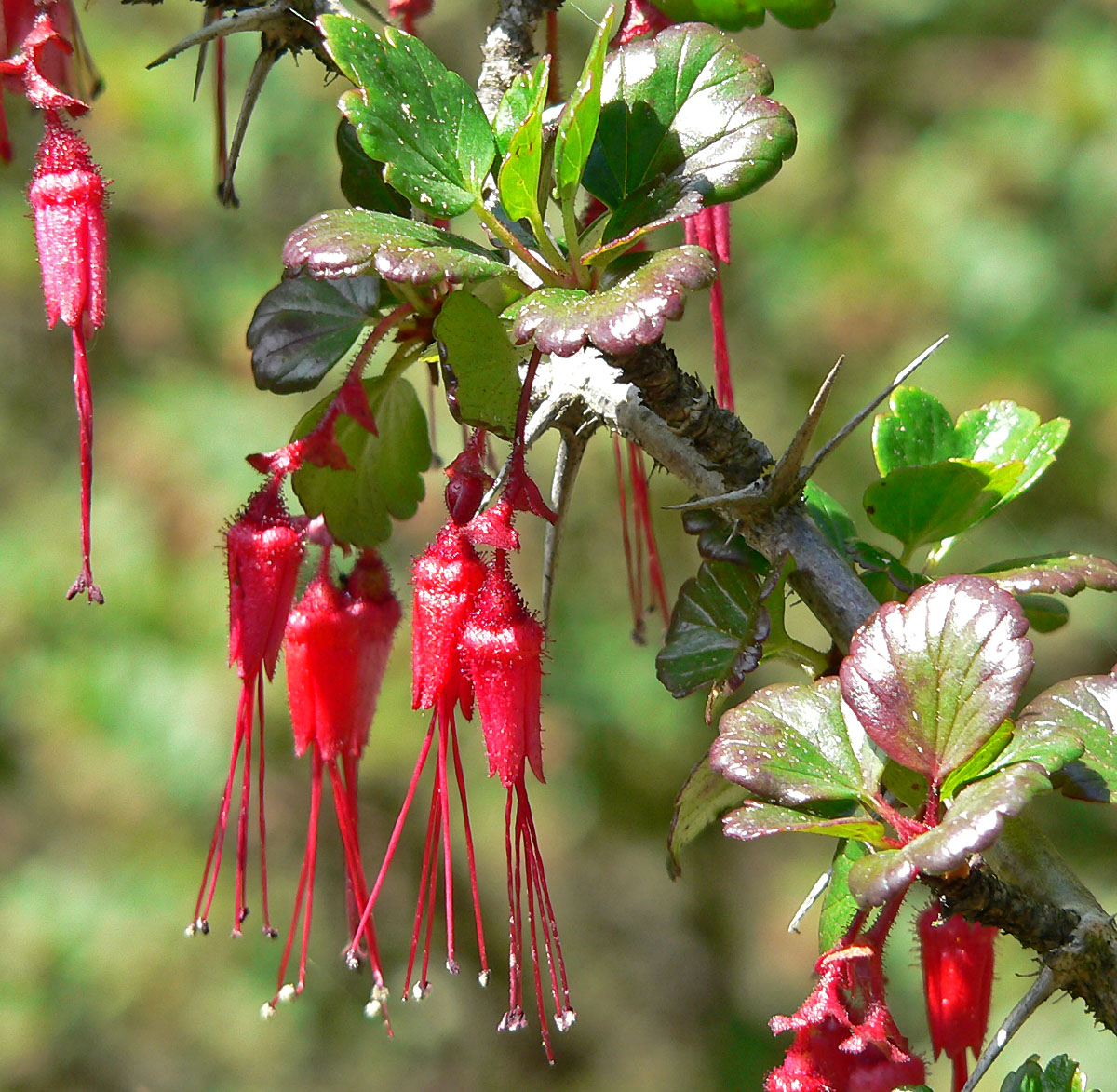
The fuchsia-flowered gooseberry is a beautiful deciduous shrub with spiny branches that can be quite intimidating. Its long, sharp, and stiff spines make it impossible for anyone or any animal to pass through the bush. The shrub produces crimson tubular flowers with long stamens and fuzzy red berries.
It can be used as an ornamental security plant along the borders or fences as a foundation planting. It grows best in full sun and USDA zones 3 to 8. The fuchsia-flowered gooseberry is characterized by its sharp spines at the stem nodes and drooping fuchsia-like blooms.
Barrel Cactus

While not a traditional shrub or vine, the barrel cactus is a large, prickly desert plant that can be used for defensive purposes. The barrel cactus has a domed shape and stiff yellow spines that can cause harm to anyone who tries to pass through. If the land is too dry or the climate is too hot for thorny bushes, a row of barrel cacti can be a good security option along boundaries.
